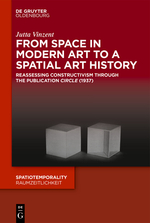
Das Verhältnis von Raum und Zeit ist in vielen wissenschaftlichen Disziplinen ein zentrales Thema geworden. So auch in der Kunstgeschichte, zu der Jutta Vinzent (Max-Weber-Kolleg Universität Erfurt und Universität Birmingham) ein neues Buch, das im Kontext der Erfurter RaumZeit-Forschung entstanden ist, vorlegt. Das Buch „From Space in Modern Art to a Spatial Art History. Reassessing contructivism through the publication Circle (1937)” ist in der Reihe “Spatiotemporality” erschienen, die auf einen interdisziplinären Austausch über Praktiken und Konzepte aus der Doppelperspektive von Raum und Zeit zielt. Im Mittelpunkt steht die Bedeutung von RaumZeit im soziokulturell-lebensweltlichen Selbstverständnis der Menschen und in medialen Repräsentationen.
Dieses neu erschienene Buch zeichnet die Theorien der Künstler des Konstruktivismus in der ersten Hälfte des zwanzigsten Jahrhunderts nach. Ausgehend von diesen Konzepten und neueren Theorien über den Raum entwickelt es eine Methodologie, die als „Spatial Art History“ bezeichnet wird und Kunstwerke als physische, raum-zeitliche Dinge begreift, die das Soziale produzieren, um das reduktive Verständnis von Kunst als bloßem Spiegel der Gesellschaft zu überwinden.
Dieses Buch richtet sich an fachlich Interessierte auf dem Gebiet der Geschichte der sozialen Kunst, der modernen Kunst, der Soziologie und der Philosophie. Infos zum Buch (Mit Bild des Buchcovers): https://www.degruyter.com/view/title/537354


